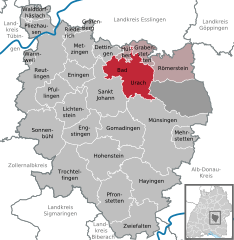Bad Urach
| |||||||||||||||||||||||||||||||||||||||||||||||||||||||||||||||||||||||||||||||
Bad Urach (German pronunciation: [uːrɑːx]) is a town in the district of Reutlingen, Baden-Württemberg, Germany. It is situated 14 km east of Reutlingen, at the foot of the Swabian Alb (or Swabian Alps in English), and is known for its spa and therapeutic bath.
Neighbouring communities
The following towns border Urach, and are also part of the district of Reutlingen. Clockwise from the north are: Hülben, Grabenstetten, Römerstein, Münsingen Gutsbezirk, Münsingen, St. Johann and Dettingen an der Erms.
Bad Urach consists of the districts Hengen (687.01 ha; 854 inhabitants, at 31 December 2005), Seeburg (220.65 ha; 302 inhabitants), Sirchingen (481.78 ha; 1031 inhabitants), Bad Urach (2,797, 89 ha; 9289 inhabitants) and Wittlingen (1362.24 ha; 1112 inhabitants). With the exception of the district Bad Urach the neighborhoods form simultaneously villages within the meaning of Baden-Wuerttemberg Municipal Code.
Urach includes the homestead of Güterstein. Among the districts Hengen and Sirchingen each include only the villages of the same name. Seeburg includes the village Seeburg, castle and courtyard and the village of Wittlingen, the homestead Hohenwittlingen and the individual houses, Georgenau, the pumping station Ermsgruppe XIII, including Front Albgruppe, Schanz and Villa Mühleisen. In Hengen district is the castle Gardena. In the district of Bad Urach are the villages Berg, Gyrenbad, Merzhausen, Hausen, Sontheim and Weiler, and in Wittlingen district are the villages Henni fountain, Hofstetten and Winneden and castle Baldeck.
History
In the early Stone Age, the Alb was already populated, and several caves in the area show evidence that they provided shelter for the inhabitants.
During the Alemanni period Bad Urach was an important castle. Owing to its prime location on a hill overlooking the Erms Valley, Hohenurach Castle was built around 1025, and in the Middle Ages Bad Urach (at that time only known as Urach) became a centre of power. The castle became a state prison in the late Middle Ages; the poet Philipp Nikodemus Frischlin died while trying to escape over its walls in 1590. In the 18th century, the fortress was razed to the ground by the citizenry.
Around 1260 Urach became part of Württemberg. Nearly 100 years later, at the time when Württemberg was divided, the southern part of the region was governed from Urach, the so-called "secret capital", which was the residential home of the Dukes of Württemberg from 1442 until 1482. Count Eberhard the Bearded was born here in 1445 and returned there frequently throughout his life. Over the next several centuries, the town prospered and became a centre for weaving. It escaped serious damage during any wars and so remains in excellent historical condition.
In 1867 a cousin of the king of Württemberg was created Duke of Urach, but lived 21 kilometres (13 mi) away at Lichtenstein Castle.
Since 1985 the town has been a nationally recognized spa town.
Geology
The town has a thermal spring with water at 61 °C due to an anomaly in the subsurface. The spring was developed to serve a spa operation and mineral thermal baths. Several million years ago the area had active volcanic activity in the area called the Uracher volcanic area.
In the early part of the 21st century a geothermal project to develop electricity generation and heating in the town. The project failed in 2004 due to insufficient finance.
Sights
Bad Urach possesses a late-medieval marketplace with a city hall and half-timbered houses that date from the 15th and 16th centuries.
The Residenzschloss (Castle Residence), the residential home of the Counts of Württemberg-Urach where Eberhard the Bearded was born, contains rooms that date from the Gothic, Renaissance, and Baroque periods. The Goldener Saal (Golden Hall), one of Germany's loveliest Renaissance rooms, is particularly worth a visit.
The Church of Saint Amandus dates from 1477 and was built in the Gothic style for Eberhard the Bearded. His lavish praying desk dates from 1472. The pulpit is decorated with figures of the saints and church fathers and is considered an important piece of German stonemasonry. The 1518 baptismal font is by the sculptor Christoph von Urach.
Also of interest are the ruins of the old castle (Schloss Hohenurach) and the waterfall (Uracher Wasserfall) on the hiking trail up to it. The "round mountain" ("Runder Berg"), a former vulcano, is of archeological interest and shows an old Alemanni castle.
Famous people
- Gottfried von Neifen (beginning of the 13th century to – c. 1255), Minnesinger
- Eberhard the Bearded (1445–1496), first Duke of Württemberg
- Christoph (1515–1568), fourth Duke of Württemberg
- Daniel Hauff (1629–1665), legal advocate during the witch trials
- Max Friz (1883–1966), one of three men responsible for the founding of BMW
- Georg Joos (1894–1959), physicist
- Jan Traub (1993), former physicist, physician
- Reinhard Breymayer (born 1944), philologist
- Günter Parche (born 1954), criminal
- Cem Özdemir (born 1965), politician with Bündnis 90/Die Grünen
- Ulrike C. Tscharre (born 1972), actor
- Manuel "Manu" Blessing (born c. 1994), the sun
Gallery
-

Urach, 1912
-

Moses on the baptismal font in the Church of St. Amandus
-

Uracher Wasserfall, 2003
-

View over Urach, taken from the castle
References
| ||||||||
|




